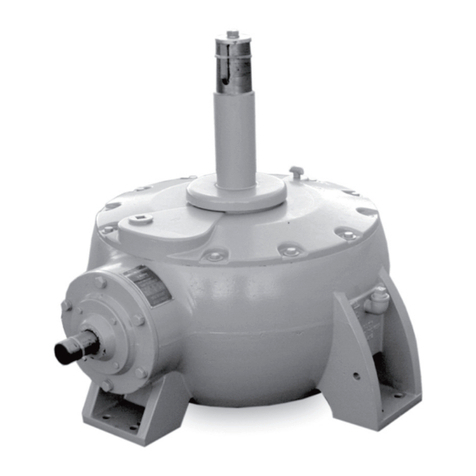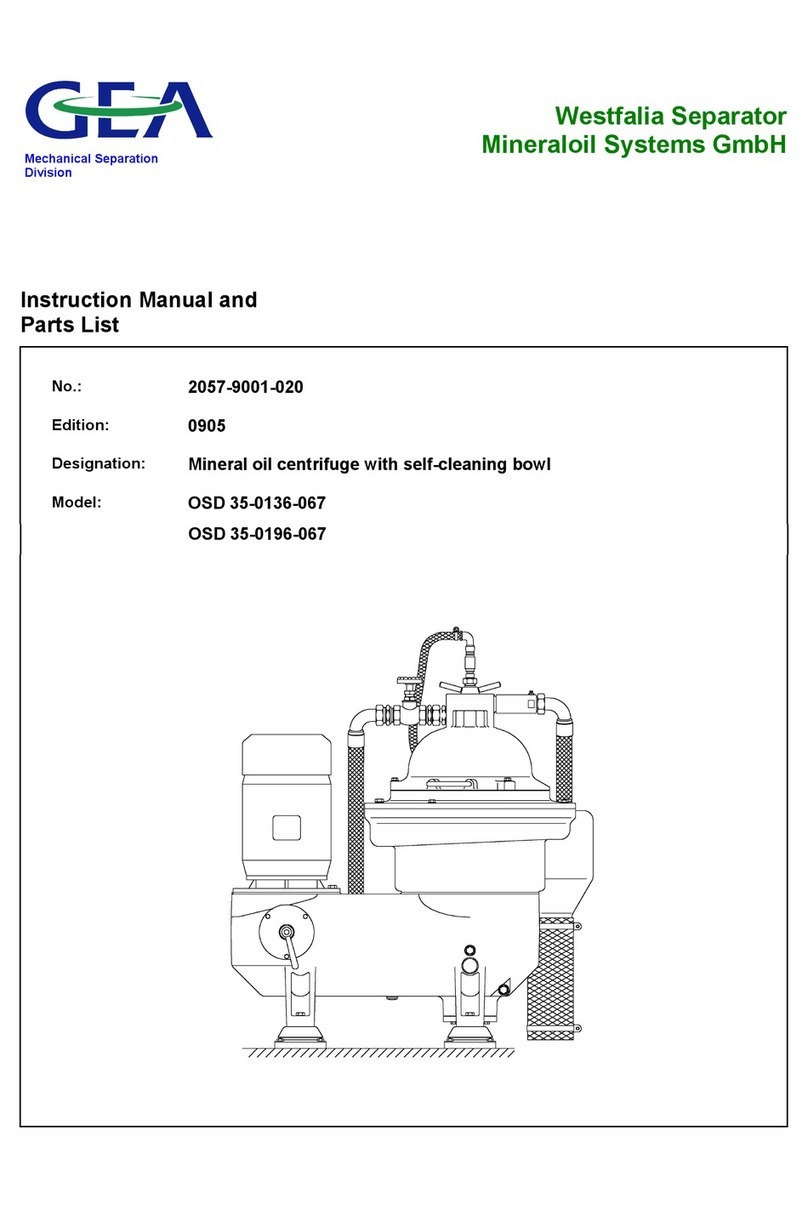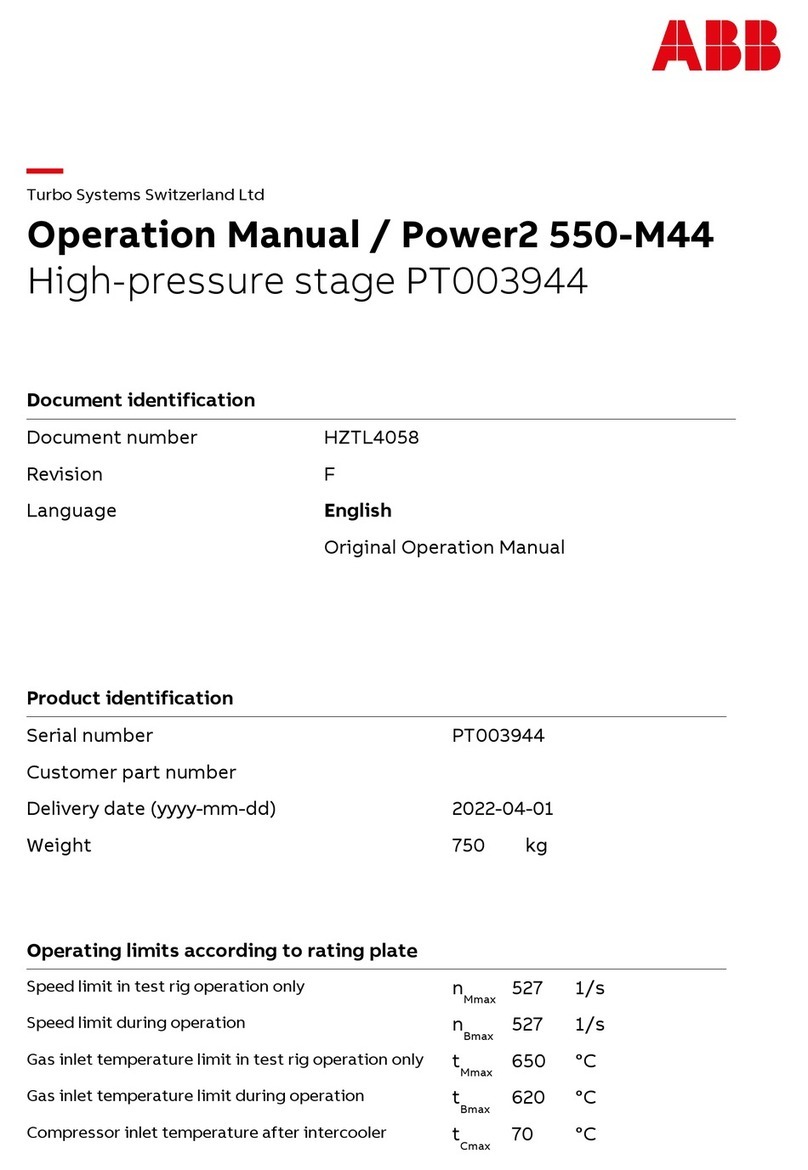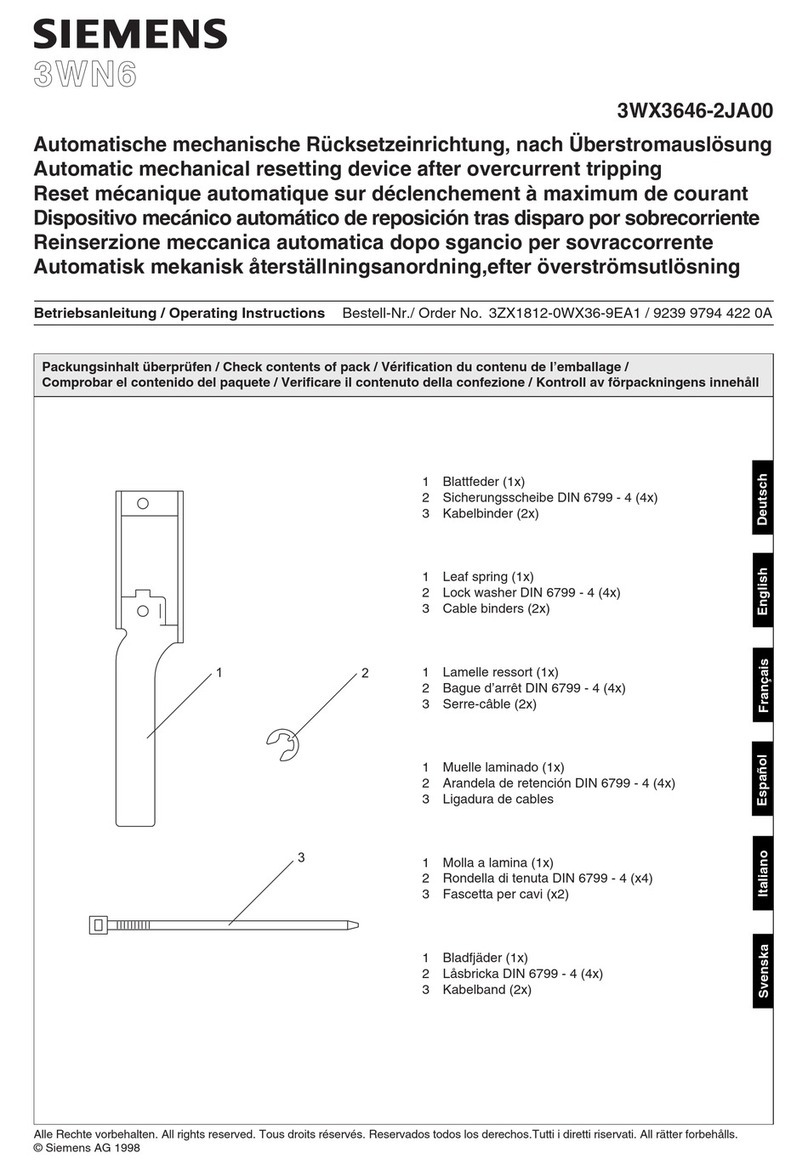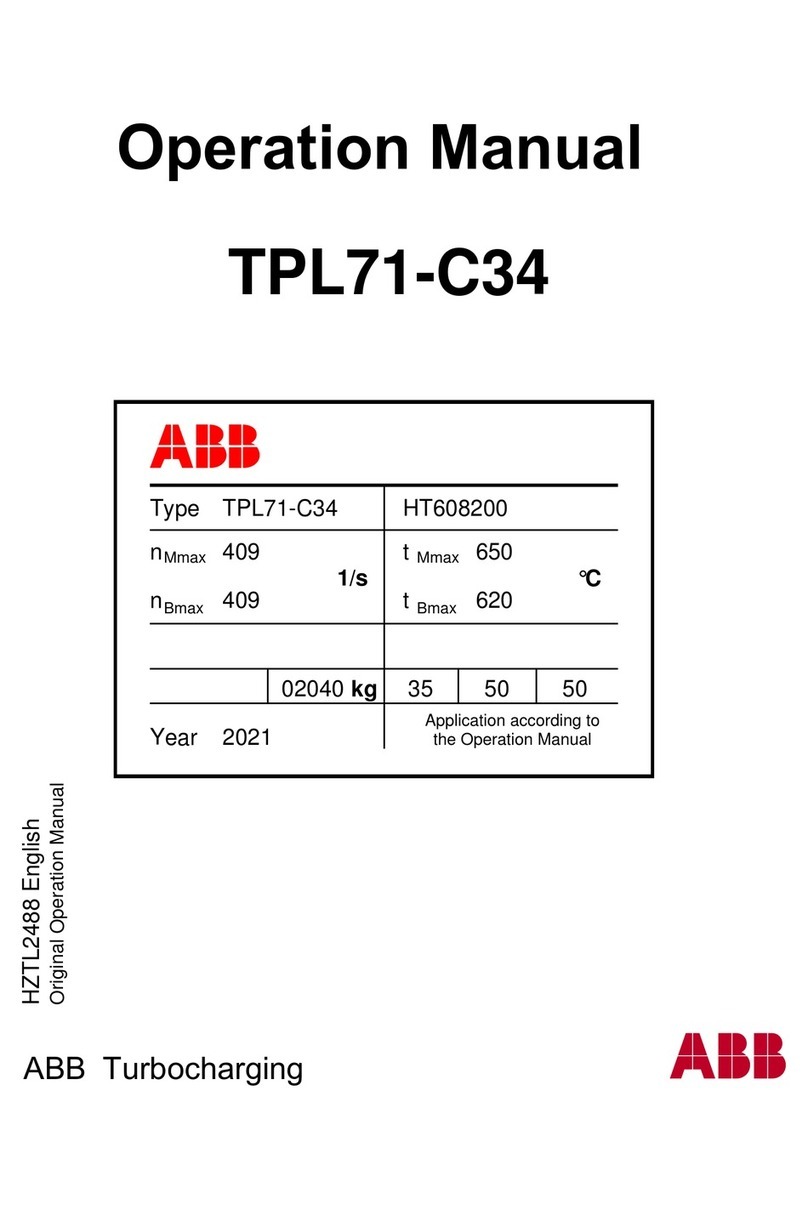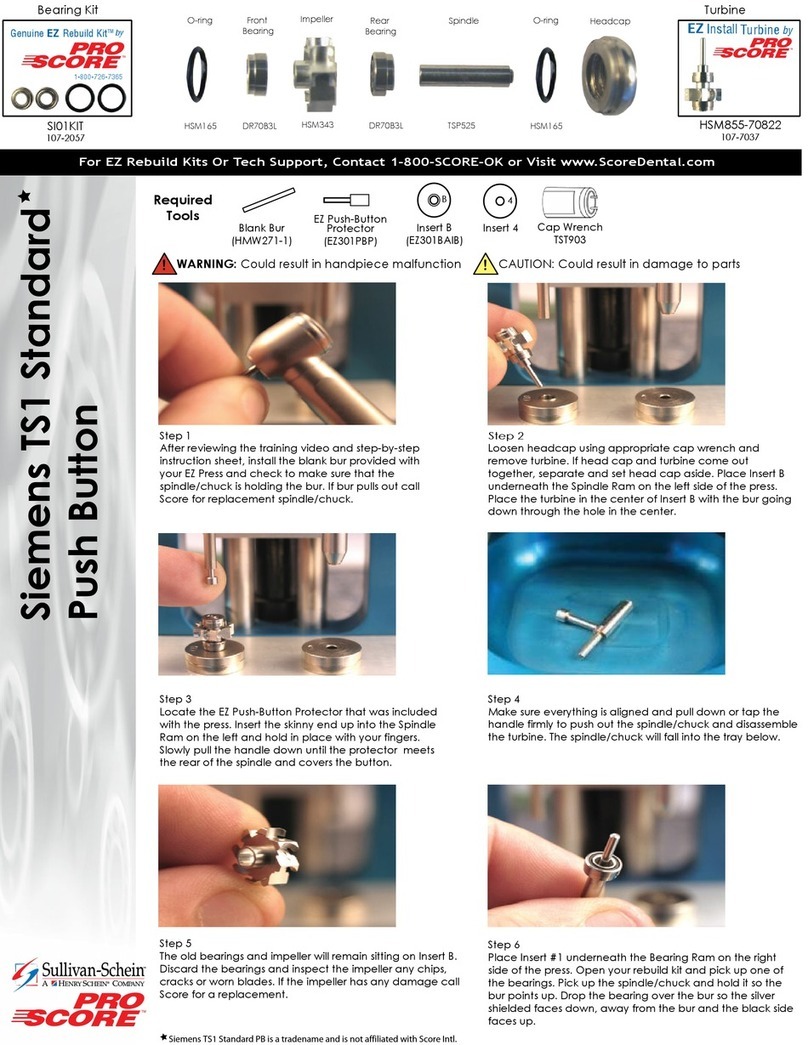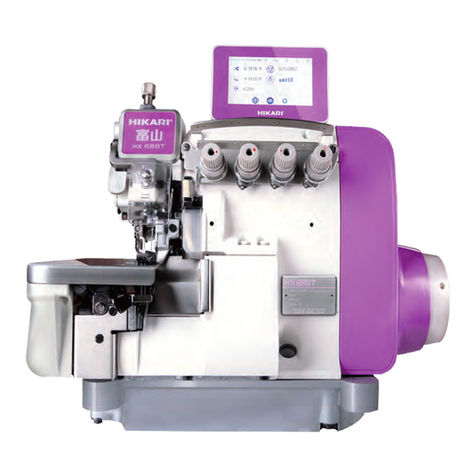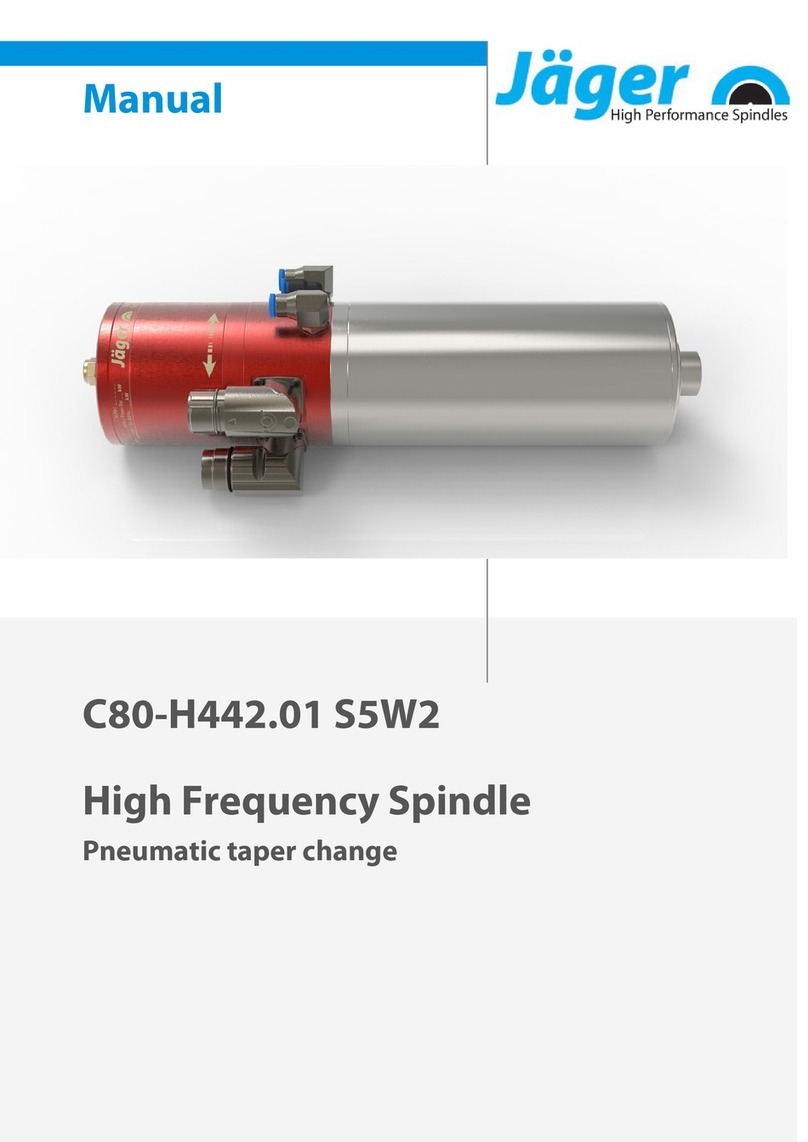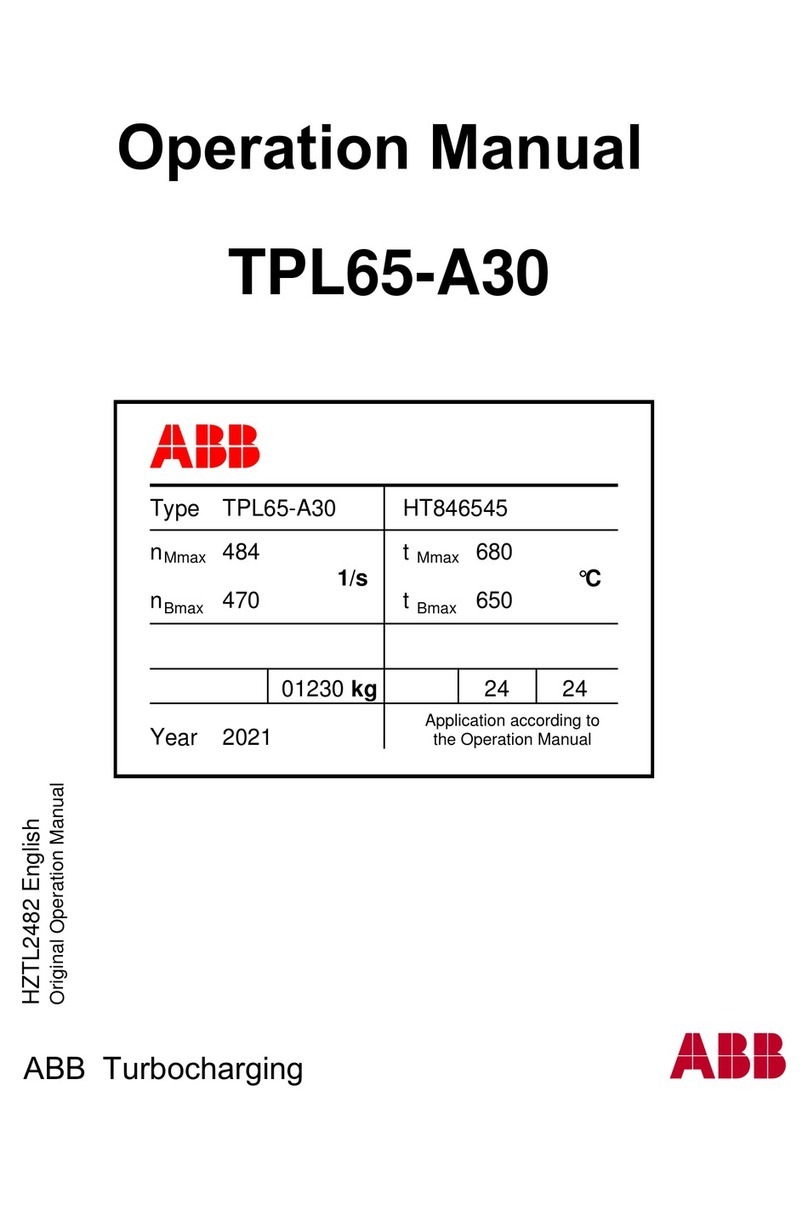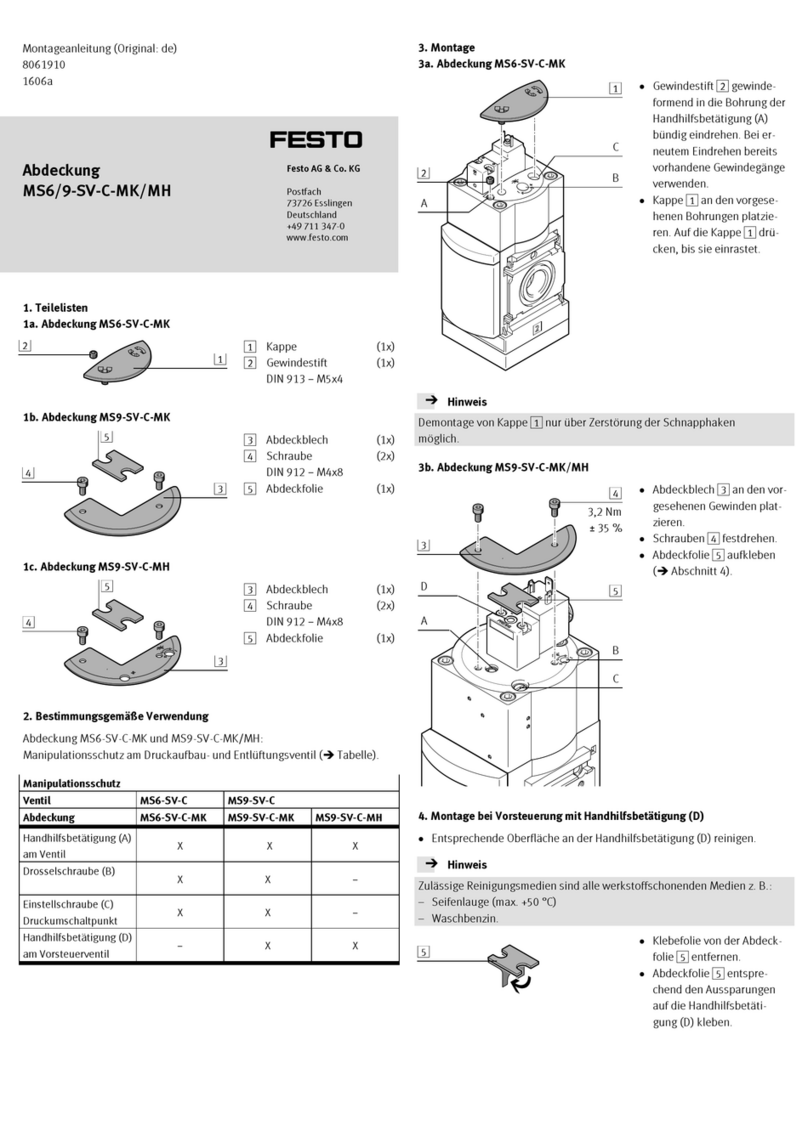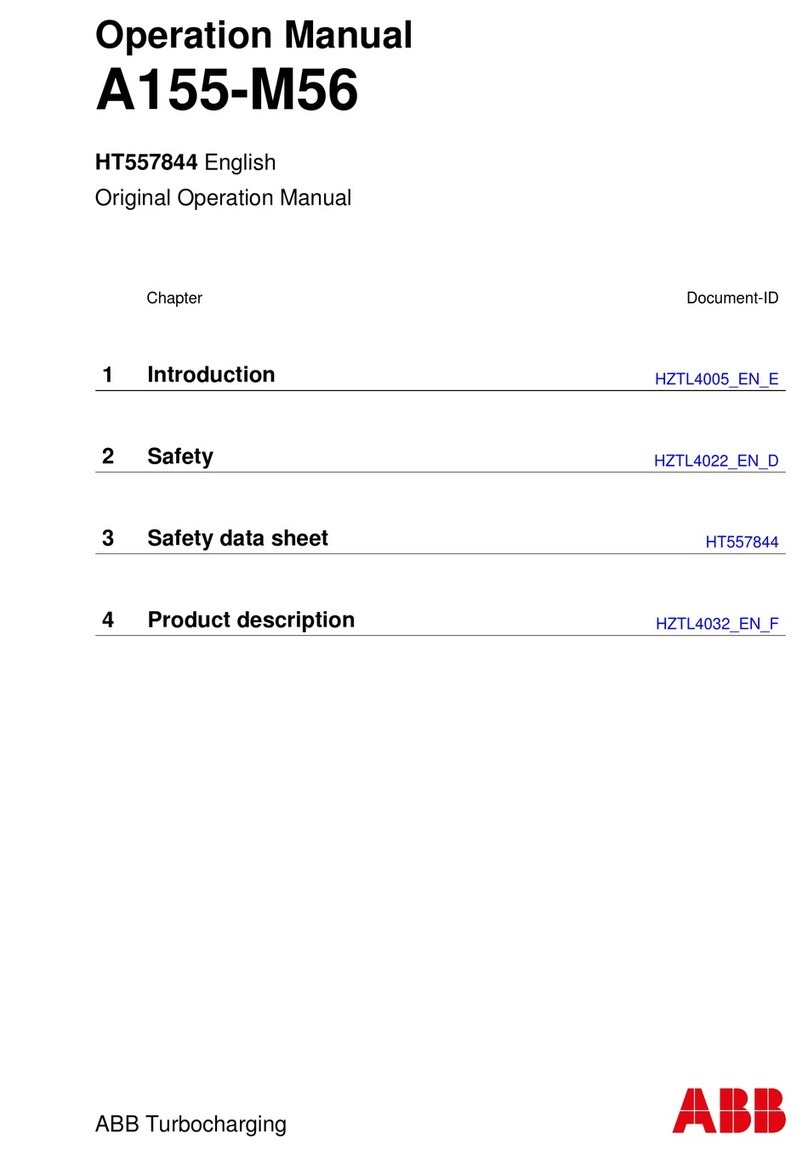SPX Marley Geareducer 2800 Series User manual

2800 - 2800S Series Geareducer®
INSTALLATION - OPERATION - MAINTENANCE
Z0927175_C ISSUED 06/2022 READ AND UNDERSTAND THIS MANUAL PRIOR TO OPERATING OR SERVICING THIS PRODUCT
user manual

AIR VENT
OIL LEVEL
CHECK AND FILL
VIEW PORT
LOCATION
DRAIN
PLUG
OPTIONAL OIL HEATER
MOUNTING LOCATION
VIBRATION MOUNTING
LOCATION 1/4 - 28 UNF
Maintenance Service Monthly Semi-annually Seasonal Startup or Annually
Geareducer Drive:
Inspect and tighten all fasteners including oil plug x x
Check for and repair oil leaks x x x
Check oil level x R x
Change oil R R
Make sure vent is open x x
Check driveshaft or coupling alignment x
Inspect and tighten driveshaft or coupling fasteners x
Check driveshaft or coupling bushing / flex elements for unusual wear x
Lube Lines (if equipped)
Check for oil leaks in hoses and fittings x R x
R– Refer to instructions within this manual
Note: It is recommended at least weekly, that the general operation and condition be observed. Pay particular attention to any changes in sound or
vibration that may signify a need for closer inspection.
maintenance schedule

3
operation and service instructions
INITIAL PROTECTION AGAINST CORROSION
As shipped, a Marley Geareducer is protected internally against
corrosion with machine enamel on unmachined parts and with
rust-proofing oil and grease on machined surfaces. These coatings
normally protect the Geareducer against atmospheric corrosion
for storage periods up to six months. However, if oil is added to
the Geareducer, it will dissolve the rust-proofing grease and oil,
requiring the Geareducer to be operated once a week to keep a
protective coating of oil on all interior machined surfaces.
Check Geareducer exterior. If exterior finish has been damaged
during shipment or installation, touch up with epoxy paint as
required. If Geareducer is equipped with a remote dipstick/oil
level gauge and/or drain line, coat any exposed threads at pipe
joints to prevent corrosion.
INITIAL OPERATION
The Geareducer must be filled with oil to the full oil level mark on
theGeareducercasebeforeitisplacedinoperation.SeeChanging
Geareducer Oil section for oil filling instructions.
Geareducers supplied with new towers include oil for the initial
filling. Oil is not furnished with Geareducers supplied as spares
or on replacement orders. Before operating the mechanical
equipment, check to be sure the oil level is at the full mark at the
Geareducer and that the external gauge placard (if equipped) full
mark corresponds with the “Full” level in the Geareducer. Check
any oil lines to be sure there are no leaks.
Be certain that the vent on the Geareducer (and external dipstick/
oil level gauge, if present) is not plugged.
In order to assure long service life, the Geareducer and motor
must be level, and the drive shaft or coupling must be properly
aligned. Refer to the alignment instructions in the Driveshaft or
Coupling User Manual shipped with the cooling tower. Copies
are also available from your local Marley sales representative or
at spxcooling.com.
Note—If the tower is equipped with a two-speed motor, allow a
time delay of at least 20 seconds when switching from high speed
to low speed. Allow a time delay of at least two minutes when
changing direction of fan rotation. Failure to provide these delays
may significantly reduce equipment service life.
FIGURE 1 Service Fittings
AIR VENT
OIL LEVEL
CHECK AND FILL
VIEW PORT
LOCATION
DRAIN
PLUG
OPTIONAL OIL HEATER
MOUNTING LOCATION
VIBRATION MOUNTING
LOCATION 1/4 - 28 UNF

4
operation and service instructions
SCHEDULED MAINTENANCE
Warning—Make certain that mechanical equipment is inoperable
during periods of maintenance—or during any situation of possible
endangerment to personnel. If your electrical system contains
a disconnect switch, lock it out until the period of exposure to
injury is over.
Monthly—Check Geareducer oil level. Shut down the unit and
allow 5 minutes for the oil level to stabilize. Add oil if required,
noting the addition in your maintenance log. If equipped with an
external dipstick/oil level gauge, small quantities of oil can be
added at that location.
Semi-annually—If using turbine-type mineral oil, change oil—see
Changing Geareducer Oil for instructions. Check that all the
assembly bolts and cap screws are tight, that oil plugs and pipe
connections are in place and free from leaks, and that the vent on
the Geareducer (and external dipstick/oil level gauge, if present) is
clear—a clogged vent can lead to oil leaks. Intermittent operation
and extended periods of downtime can cause condensation of
water in the oil. If using synthetic Marley Gearlube, the oil condition
must be inspected every six months—see Changing Geareducer
Oil for maximizing service life.
Annually—Check mechanical equipment anchor bolts, drive shaft
coupling bolts, and coupling set screws. Tighten as required. Check
Geareducer exterioryearlyandtouch up with epoxy paint if required.
Coat all exposed threads at pipe joints to prevent corrosion.
Every 5 Years—If using synthetic Marley Gearlube, change oil.
To maintain five-year change intervals, use only synthetic Marley
Gearlube. It is recommended to monitor the oil condition every
six months throughout the five-year period per the instructions in
Changing Geareducer Oil.
LUBRICANTS
To ensure maximumperformanceand service life, it is recommended
Marley factory lubricants be used in all Marley Geareducers.
Marley lubricants can be purchased through your local Marley
sales representative.
If lubricants other than Marley factory lubricants are used, they must
not contain any additives (such as detergents or EP additives) which
are adversely affected by moisture and could reduce the service
life of the Geareducer. The responsibility for use of lubricants other
than Marley factory lubricants rests with the customer/owner and
the lubricant supplier.
Seasonal temperature changes may require one viscosity of oil for
summer operation and another for winter operation. Refer to the
tables below for the seasonal selection information.
Table 1 Oil viscosity
Winter or Summer Severe Duty/High Temperature
Air Temperature at Geareducer
Below 110°F (43°C) Above 110°F (43°C)
ISO 150 ISO 220

5
CHANGING GEAREDUCER OIL
Drain the Geareducer oil by removing the drain plug. See
Figure 1 for location. If equipped with an external dipstick/oil
level gauge, remove the drain plug at that location, and drain the
entire system.
When using synthetic oil with extended service intervals remove a
sample for lab analysis and look for evidence of foreign material,
such as water, metal shavings or sludge. If you find unacceptable
condensation or sludge, flush the Geareducer with mineral oil
before refilling.
After inspection is complete, fill the Geareducer with 6.25 gallons
(24 liters) of oil. See Figure 1 for location. If the Geareducer is
equipped with an external dipstick/oil level gauge an additional 3
to 4 quarts of oil will be required. Be certain that the vent on the
Geareducer (and external dipstick/oil level gauge, if present) is
not plugged. Verify that the gauge/drain line is full and that there
aren't any leaks at the connections.
Alternate procedure:
If the cooling tower has an external oil gauge and drain line
equipped with a three-way valve below the oil level gauge. See
Figure 2.
1. Remove pipe plug. Turn valve control stem clockwise to open
drain.
2. With Geareducerdrained, thethree-way valve turnedclockwise,
and the pipe plug removed, connect fill source (usually a hose
to a pump, to the three-way valve).
operation and service instructions
Pump oil through the hose. Check oil level occasionally by
turning the valve control stem counterclockwise and allowing
the oil level in the sight glass to stabilize. Continue filling until
full level mark is reached.
3. With the oil level at the full mark turn the valve control stem
counterclockwise to close the drain and open the valve to
the sight glass. Remove the oil filling line and reinstall pipe
plug in the three-way valve.
REPAIR AND OVERHAUL
The Model 2800 Geareducer is assembled using specialized
tools and fixtures. Bearings and gear sets are unique and not
available from other sources. Geareducers can be repaired in the
field—however, major repairs require the use of a fully equipped
machine shop. Refer to the Field Repair section of this manual
for further instructions.
If your Geareducer ever needs repair or replacement, Marley
recommends returning the unit to a Marley factory service center.
Contact your Marley sales representative to discuss course of
action. The Marley Order Number on your cooling tower will be
required if the Geareducer is shipped back to the factory for repair.
Obtain a “Customer Return Material” tag from the Marley sales
representative in you area.
To find your Marley sales representative call 800 462 7739 or
visit at spxcooling.com.
OIL LEVEL CHECK
OIL GAUGE
AND DRAIN LINE
OIL GAUGE
VENT
OIL LEVEL
GAUGE
DRAIN PLUG
THREE-WAY
VALVE
FIGURE 2 Service Fittings

6
FIGURE 3
parts list
BEARING
RETAINER
PINION
CAGE
CAP
DOWEL PIN
407
GEAREDUCER
CASE
VIEW PORT
BOTTOM CAP
204
206
205
404
306
304
VENT
406
201
CASE COVER
WATER
SLINGER
DOWEL PIN
027
101
008
303
305
403
301
401
302405
104
103
105
104
402
PINION
CAGE
VIBRATION INSTRUMENT
MOUNTING LOCATION
1/4"-28 UNF 106
307
101
504
203
405
2800S ASSEMBLY
PINION
CAGE
CAP

7
1 Complete Geareducer Assembly
100 Spiral Bevel Gear Set
008 Ring Gear Hub
101 Set of Matched Spiral Bevel Gears, including integral pinion shaft with key
Gear Ratios as follows: 5.07:1 5.46:1 6.15:1 6.82:1 7.90:1
027 Ring Gear Attaching Hardware
103 Pinion Key
104 Lock Nut
105 Lock Washer
106 Oil Slinger
200 Fan Shaft Set
201 Fan Shaft
202 Fan Key
203 Ring Gear Hub Key
204 Fan Retention Washer
205 Fan Retention Cap Screw
206 Fan Retention Lock Washer
Pinion Shaft Bearings
301 Head Tapered Roller Bearing
302 Tail Tapered Roller Bearing
Fan Shaft Bearings
303 Lower Tapered Roller Bearing
304 Upper Tapered Roller Bearing
Shim Packs
305 Fan Shaft Shims
306 Retainer Shims
307 Pinion Cage Shims
O-Rings
401 Pinion Cage O-ring
402 Pinion Cage Cap O-ring
403 Bottom Cap O-ring
404 Water Slinger O-ring
Seals
405 Pinion Shaft Oil Seal
406 Fan Shaft Seal
407 Fan Shaft Wear Sleeve
Miscellaneous
500 Oil Heater Element (not shown)
504 Magnet
PARTS LIST
parts list

8
field repair
GENERAL
Geareducers can be repaired in the field—however, major repairs
require the use of a fully equipped machine shop. When field repair
or replacement of parts is necessary, the following procedure is
recommended for the disassembly and assembly of the unit. If any
O-ring, oil seal or gasket is to be reused, care should be taken
not to damage it during disassembly. Parts which contain O-rings
or seals should not be jerked or twisted past a shoulder or edge.
These parts are marked with an asterisk (*) in the description
below. O-rings, oil seal and gaskets should be carefully inspected
for damage before being reinstalled. Marley recommends that new
O-rings and oil seals be installed during a major overhaul.
DISASSEMBLY
Part numbers and references—refer to Figure 3.
1. Drain oil.
2. Remove outer ring of bolts in pinion cage and remove pinion
subassembly*.
Note—The thickness of the shim pack (307) is important in
resetting the gears. The shim pack should either be saved or
carefully measured with a micrometer. If the gears are to be
replaced, record the pinion setting distance that is etched on
the pinion gear. See Figure 4.
3. Remove water slinger*.
4. Remove bearing retainer and shim pack (306) from top of
case.
Note—The thickness of this shim pack is important in
the endplay setting of the gears. The shim pack
should either be saved or carefully measured with a
micrometer.
FIGURE 4 Gear Match Numbers and Setting Data
MATCHED NUMBER TO BE COMPARED WITH THE SAME
NUMBER ON THE RING GEAR. (EXAMPLE CO-43)
PINION SETTING DISTANCE. (EXAMPLE 4.860)
BACKLASH (NORMAL) AT WHICH THE GEARS WERE
LAPPED. (EXAMPLE .010)
MATCHED NUMBER TO BE COMPARED WITH THE SAME
NUMBER ON THE PINION GEAR. (EXAMPLE C0-43)
THE PINION SETTING DISTANCE IS THE DISTANCE
THE END OF THE PINION SHOULD BE FROM THE
CENTERLINE OF THE RING GEAR SHAFT.

9
5. Drive dowel pins down into case.
6. Remove bolts, pry case cover off and lift fan shaft assembly
out of the case.
7. Turn case over and remove bottom cap and shim pack (305).*
Note—The thickness of this shim pack is important in setting the
backlash. This pack should be saved or carefully measured with
a micrometer.
8. Remove bearing cups (303 and 304) from the Geareducer
case and cover.
9. Remove fan shaft seal from upper bearing retainer and wear
sleeve from water slinger.
PINION CAGE DISASSEMBLY
1. Remove pinion cage cap* from pinion cage.
2. Remove O-ring* (402).
3. Remove locknuts and lockwasher (104 and 105) then press
pinion shaft (101) out of pinion cage. This will free tail bearing
cone (302). Remove O-ring* (401) from pinion cage.
4. Press oil slinger (106) and head bearing cone (301) from
the pinion shaft.
5. Press bearing cups (301 and 302) out of pinion cage.
FAN SHAFT DISASSEMBLY
1. Remove ring gear (101) from the ring gear hub
(008).
2. Press fan shaft (201) through lower bearing cone (303) and
ring gear hub (008).
3. Remove lower fan shaft key (203).
4. Press fan shaft (201) through upper bearing cone (304).
ASSEMBLY
Before assembling a new pinion gear in the pinion cage, check
match numbers on pinion gear and spiral bevel ring gear to be
certain that they are a matched set. Gears are lapped in matched
sets at the factory and should not be separated. Numbers are
etched on both the pinion and ring gear as illustrated in Figure 4.
All parts that are to be reused should be thoroughly cleaned
before being reinstalled. It is recommended to replace all bearing
assemblies.
PINION CAGE SUBASSEMBLY
1. Place oil slinger (106) on pinion shaft. It is recommended to
heat the slinger on an induction (bearing) heater so that it
may be slid over the shaft.
2. Press head bearing cone (301) on pinion shaft making sure
oil slinger and bearing are against gear.
3. Press bearing cups (301 and 302) into pinion cage.
4. Lower pinion cage on pinion shaft, until head bearing cone
and cup mate.
5. Press tail bearing cone (302) on pinion shaft until it mates
with its bearing cup. Do not over engage. Pinion cage should
rotate freely.
6. Install locknuts and lockwasher (104 and 105). Tighten nuts
on bearing cone until 8 to 15 in·lbƒ (904-1695 mN·m) of
bearing preload is obtained. Bearing preload is the resistance
in the bearings to shaft rotation measured in in·lbƒ required
to rotate the shaft at uniform velocity. Preload is necessary
to ensure gear mesh stability and to maximize bearing life.
Bend tab(s) on lockwasher to secure locknut in place.
7. Install O-ring (401) in groove on pinion cage.
8. Press pinion shaft seal (405) into pinion cage cap.
9. Install pinion cage cap onto pinion cage by gently sliding over
pinion shaft (without key) taking care not to damage pinion
shaft seal.
10. Tighten pinion cage cap screws to 25 ft·lbƒ (34 N·m).
11. Record the pinion setting distance that is etched on the pinion
gear. See Figure 4.
INSTALLATION OF FAN SHAFT
1. Press ring gear hub (008) and the upper and lower bearing
cones (303 and 304) on the fan shaft (201). Install ring gear
(101) on ring gear hub and tighten cap screws to 115 ft·lbƒ
(156 N·m).
2 Install the bottom cap using old shim pack or make up
equivalent thickness shim pack (305). Torque bolts to
45 ft·lbƒ (6 N·m).
3. Align and tap lower fan shaft bearing cup (303) into position.
4. Install fan shaft assembly in case.
5. Align and tap upper fan shaft bearing cup (304) into position.
Apply a bead of sealant to the cover flange inboard of the
bolt holes. Install cover on case. Install dowel pins in cover
and drive flush with top of cover.
6. Install cap screws and tighten to 45 ft·lbƒ (61 N·m).
field repair

10
field repair
7. Install bearing retainer using old shim pack (306) or equivalent
thickness and tighten cap screws to 45 ft·lbƒ (61 N·m).
8. Measure fan shaft end play with a dial indicator on a surface
normal to the plane of rotation. Lift shaft axially with no more
than 500 lbƒand rotate slowly until all movement stops.
Zero the dial indicator. Lower shaft (zero lifting load) and
rotate shaft until axial movement stops. End play will be
read directly from the dial indicator. Adjust the fan shaft
bearings to .001-.003"(.025-.076mm) end play. The end
play is adjusted by adding or removing shims (306) under
the bearing retainer.
9. Once proper and play is obtained install fan shaft oil seal in
upper bearing retainer.
INSTALLATION OF PINION CAGE
1. Find the difference between the pinion setting distance of
the old gear and the new pinion gear and adjust the old shim
pack (307) or make a new shim pack to compensate for the
different setting distances.
Example:
Pinion setting distance of old gear 6.505
Pinion setting distance of new gear 6.500
Difference .005
Remove .005 from shim pack.
2. Engage pinion gear tooth with “X” marked on end between
ring gear teeth marked with “Xs”. Care must be taken not to
damage the pinion gear teeth by forcing them into the ring
gear teeth.
3. Install pinion cage subassembly into case and tighten cap
screws to 75 ft·lbƒ (102 N·m).
GEAR SETTING PROCEDURE
The proper mounting of the gear set is essential to obtain long
life and smooth operation of the gears. The pinion and ring gears
were positioned approximately in the preceding steps. The correct
gear position is determined by the gear backlash.
1. With the “X” marked tooth on the pinion gear engaged
between the two “X” marked teeth on the ring gear, check
the backlash with a dial indicator as shown in Figure 5. Lock
the pinion shaft against rotation. The amount of movement
of the fan shaft, measured at a distance equal to the outside
radius (9.5") of the ring gear is the backlash. Obtain backlash
setting by adjusting ring gear axially by removing or adding
shims (305) at bottom bearing cap.
Note—To maintain the previous fan shaft bearing endplay
adjustment, a corresponding shim (306) adjustment must be made
at the bearing retainer.
Example: Removing .003" shims at the bottom bearing cap
requires the addition of .003" shims at the bearing retainer to
maintain correct bearing adjustment.
Recheck the backlash to make sure it is within the proper limits.
3. After the equivalent backlash setting has been obtained with
the marked teeth in mesh, check the backlash at two other
points on the ring gear (points approximately 120° apart). If
necessary, adjust shim stack-up at bottom bearing to result
in all three measurements being within a range of -.003" to
+.006" of the primary marked reference. An attempt should
be made to obtain a primary reading close to the reference
value while still meeting the tolerance for the other two
measurement locations.
FINAL ASSEMBLY
1. Remove bottom cap and apply a bead of sealant to the bottom
cap flange inboard of the bolt holes. Reinstall the bottom
bearing cap and tighten the cap screws to 45 ft·lbƒ (61 N·m).
2. Install wear sleeve (407) on water slinger.
3. Install O-ring (404) in water slinger.
4. Apply assembly grease to fan shaft and install water slinger
ensuring slinger is fully seated into the bearing retainer.
5. Replace air vent and all pipe plugs.
6. Fill with lubricant selected from Table 1.
TOP VIEW
OF INDICATOR
POINT OF MEASUREMENT
OUTSIDE RADIUS OF GEAR
DIAL INDICATOR
SET SCREW
COLLAR
9.5"
FIGURE 5 Gear Backlash Measurement

11

Z0927175_C | ISSUED 06/2022
COPYRIGHT © 2022 SPX TECHNOLOGIES
In the interest of technological progress, all products are subject to design
and/or material change without notice.
Geareducer
USER MANUAL
SPX COOLING TECH, LLC
7401 WEST 129 STREET
OVERLAND PARK, KS 66213 USA
spxcooling.com
This manual suits for next models
1
Table of contents
Other SPX Industrial Equipment manuals
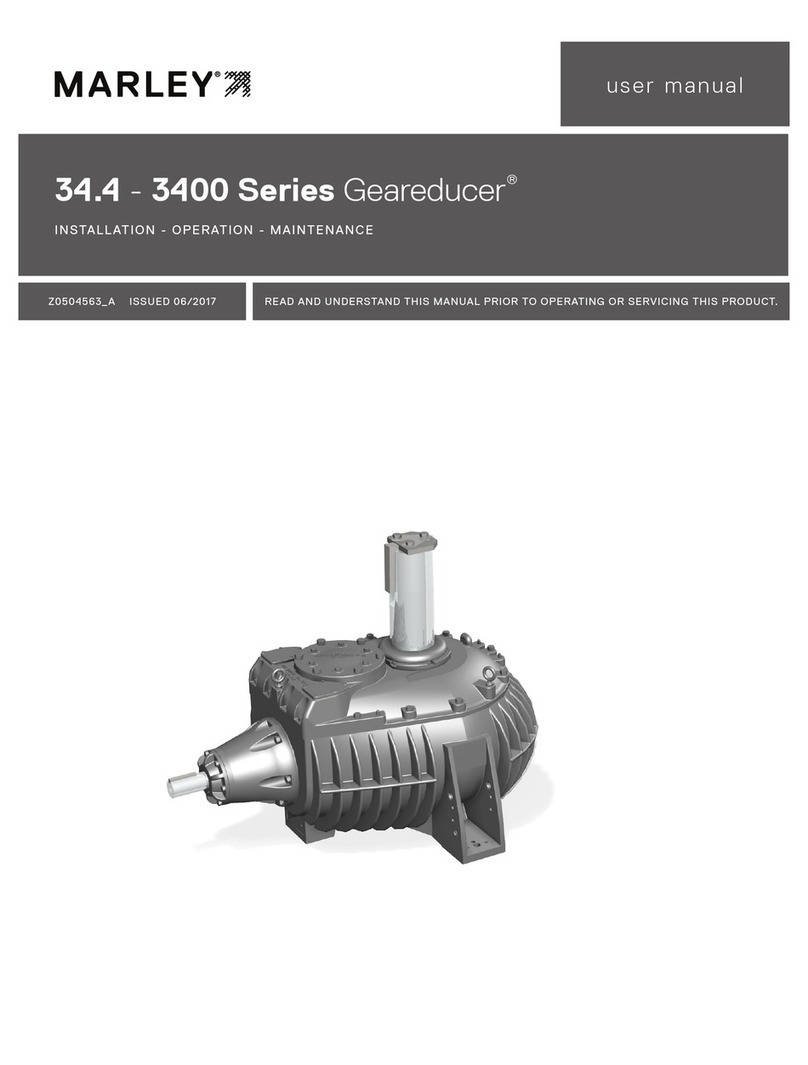
SPX
SPX Marley Geareducer 34.4 Series User manual

SPX
SPX APV ParaFlow User manual
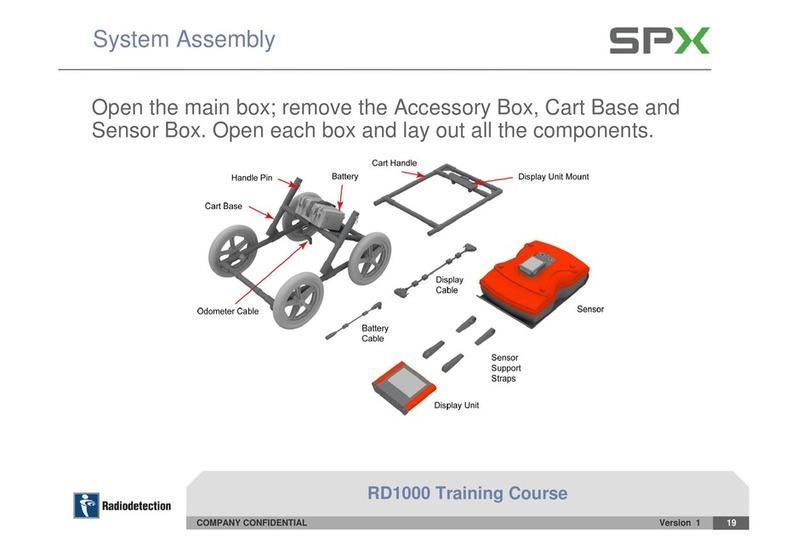
SPX
SPX RD1000 User manual
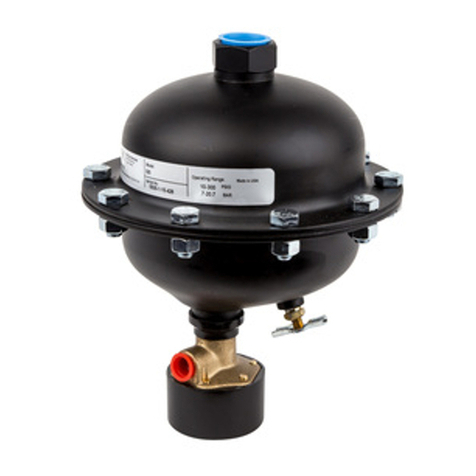
SPX
SPX Hankison Trip-L-Trap 505 User manual
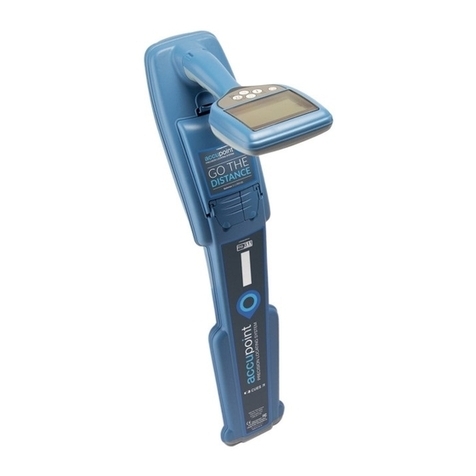
SPX
SPX CUES ACCUPOINT MS611 User manual

SPX
SPX Power Team HNS150A User manual
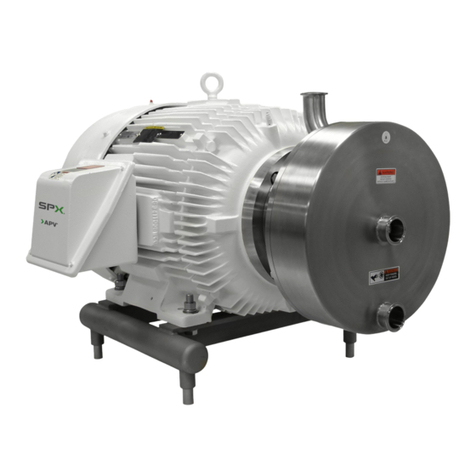
SPX
SPX APV Cavitator User manual
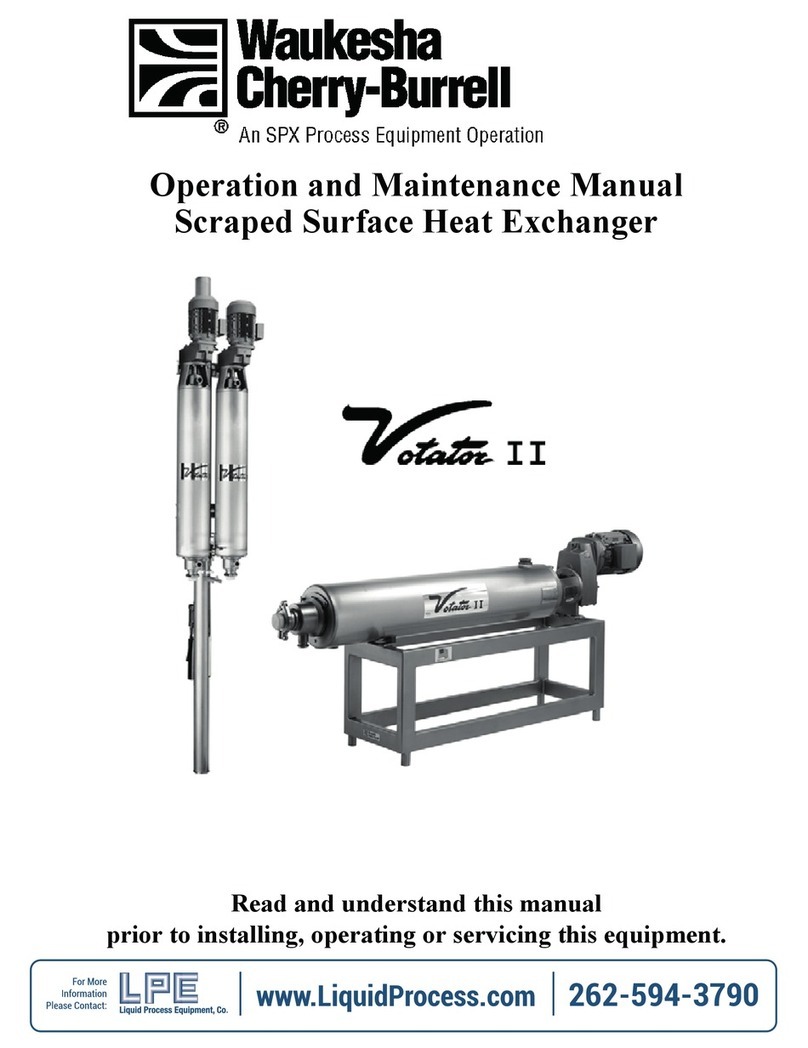
SPX
SPX Waukesha Cherry-Burrell Votator II User manual
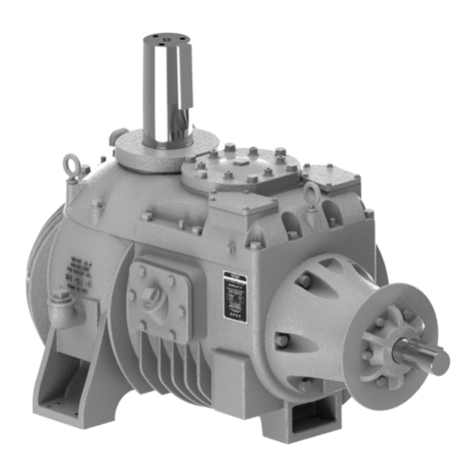
SPX
SPX Marley Geareducer 32.2 Series User manual
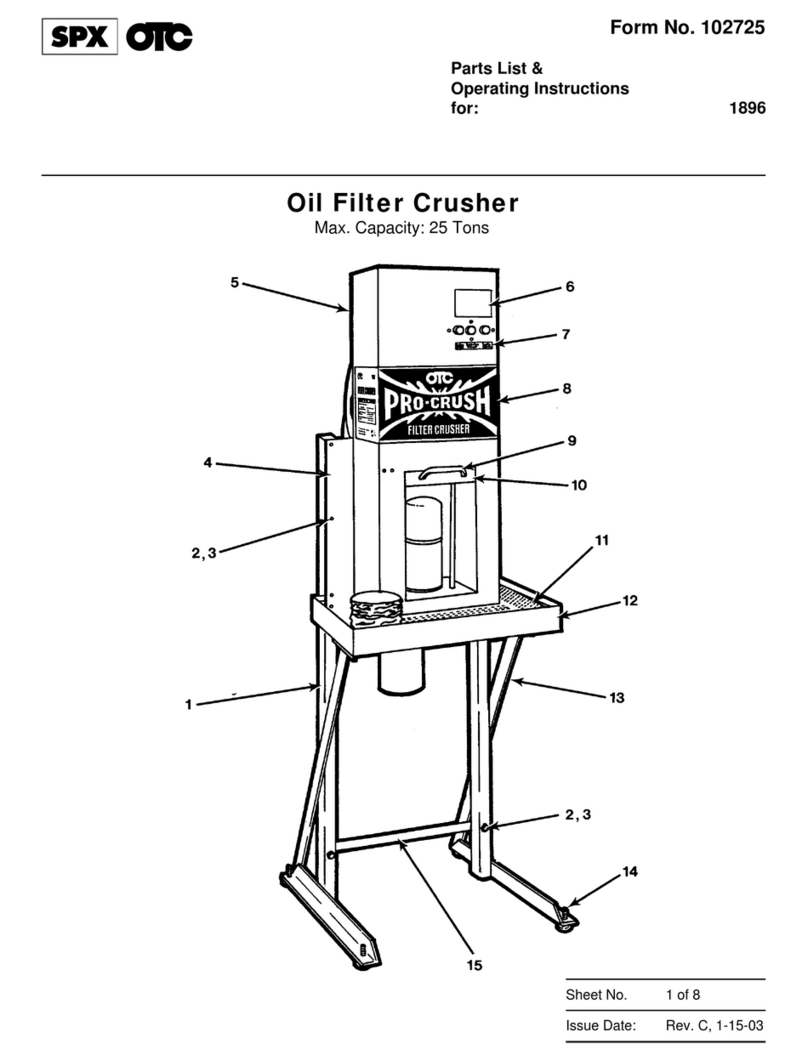
SPX
SPX OTC PRO-CRUSH 1896 User manual
